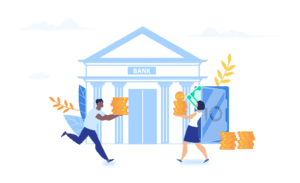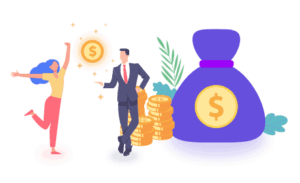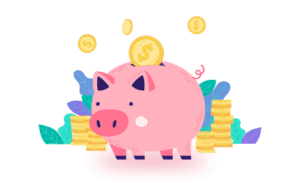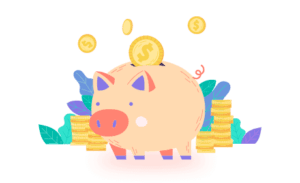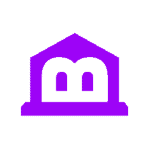The banking industry makes it easy for people to store money, borrow capital, and build wealth. It’s a critical component of society that offers financial safety for your extra cash. Banks are insured by the Federal Deposit Insurance Corporation, but there’s more to choosing the right bank than making sure it has this critical policy. This banking overview will cover what to look for in an optimal banking experience.
Popular Banks
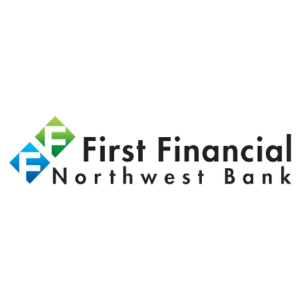
Looking for a reliable banking option? Read this First Financial Northwest Bank review to discover their services and benefits.
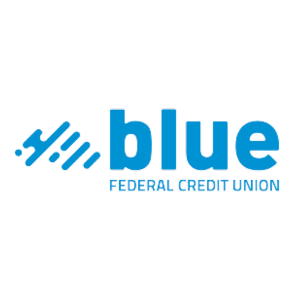
Discover the benefits of banking with Blue Federal Credit Union. Get insights into their services, rates, and membership perks.
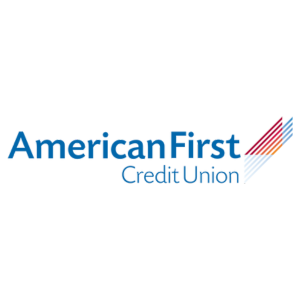
Discover everything you need to know about American First Credit Union. Explore their services, benefits, and membership options.
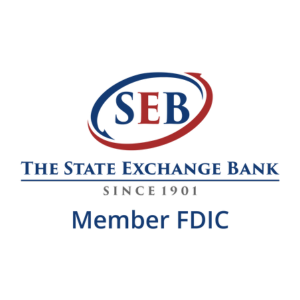
Looking for a reliable banking option? This review of State Exchange Bank highlights its features, services, and why it’s a great choice.
Why Choosing the Right Bank Matters
The right bank can make a big difference in your finances. Understanding how banking can have a long-term impact on your life will reveal the significance of this decision.
Personal vs. Business Banking
Some business owners look for a good experience for personal and business banking, while others only care about the personal side. If you plan to separate your personal finances from your business finances, it’s important to have separate accounts. If you are looking for a business banking solution, read this guide about business banking.
Personal accounts have basic features like a high-yield savings account, budgeting tools, access to personal loans, and other resources that can help you manage your finances. Business banking is a bit more advanced. Some banks offer resources to help business owners create invoices, send payment requests, manage their tax deductions, and perform other tasks.
Regardless of which type of account you want, it’s important to view a bank as more than just a place to store money. The additional resources banks provide can create a significantly different banking experience.
The Importance of Banks for Your Finances
Before diving into how banks are important for our finances, it is a good idea to explore how money is important for our long-term goals. Making more money gives consumers more options and greater peace of mind. Not living paycheck to paycheck can free you from financial stress. Picking up side hustles can help, but pursuing career advancement opportunities is even more important since you can then charge more money for the same hour of time.
You can work hard for your money, but if you lose that money, it won’t matter. Furthermore, if you keep that money tucked away under the rug, it will lose value each year due to inflation. Banks solve this problem by protecting the funds in your account — up to $250,000 per account category — through the FDIC. Even if the bank defaults, your funds are safe.
Banks also offer financial products that make it easier to borrow money and build wealth. Some banks have lower interest rates than others for their loans. The difference between a single percentage point can save you thousands of dollars over your lifetime. Similarly, you can put your money in a high-yield savings account. If you put $100,000 into one of these accounts, the difference between 2% APY and 4% APY is an extra $2,000.
Banking is important, but it’s also important to choose the right bank. Choosing banks with lower costs and higher returns can help you achieve your financial goals sooner.
Types of Banks
Consumers can choose from many types of banks. These are some of the choices to consider.
Traditional Brick-and-Mortar Banks
Traditional brick-and-mortar banks have been around the longest. These are the corporate giants of the world: Citibank, Bank of America, Wells Fargo, Chase, and many others. Traditional banks have physical branches throughout the country. The largest banks have thousands of branches, while regional banks may only have a few branches.
Digital/Online Banks
Digital banks, also known as online banks, operate online. Some of these banks only have an online presence and do not have any physical banks. These online banks often have large ATM networks to compensate for zero physical branches. Digital banks have less overhead, which makes it easier to eliminate many common fees and set higher interest rates for their savings accounts.
Most traditional banks also have a digital component. For these banks, as well as the digital-only banks, you can access your bank account information through a mobile app or browser. Banks invest a lot of money into their cybersecurity to ensure their users’ information is safe.
Many digital banks offer banking services through a partnership with a traditional FDIC-insured bank. Under this arrangement, the company offering digital banking services refers to itself as a fintech company instead of as a bank.
Neobanks
Neobanks operate in a similar way as digital banks. Both types of banks have digital presences. While some online banks also have brick-and-mortar branches, Neobanks do not have physical branches.
Another key distinction is that neobanks are not affiliated with a traditional FDIC-insured bank. The neobank is insured by the FDIC without the intervention of another financial institution. Neobanks are their own entity, while online banks that aren’t neobanks depend on another institution to maintain FDIC status. All Neobanks are online banks, but not all online banks are neobanks.
National Banks
National Banks are member banks of the Federal Reserve. These banks help with buying and selling U.S. Treasury bonds. Many of these large national banks are the ones you already know: Bank of America, Chase Bank, Citibank, Capital One, and PNC Bank are some of the financial institutions that are in this category. Opposite to national banks, you can choose to bank with community banks that are locally oriented and tend to operate in one state or smaller area.
Private Banks
Private Banks offer the accounts you would expect to find in a regular bank. Private banks offer checking accounts, savings accounts, loans, and other financial products. However, private banks are specifically created for high-net-worth individuals. That results in different types of product offers, deals, and other perks.
Ethical Banks
Ethical Banks do not exclusively focus on profits. They address objectives that usually align with ESG in addition to generating profits. Ethical banks tend to have the same accounts and resources as traditional banks.
Minority Banks
A minority bank is a financial institution whose shares are mostly owned by socially and economically disadvantaged individuals. One person in this category can hold 51% or more of the shares, or it can be a group of socially or economically disadvantaged individuals who have a cumulative majority position. As an example, read this guide about Black-Owned Banks and how they constitute a minority banking sector.
Credit Unions
Credit Unions are not-for-profit financial institutions that offer checking accounts and savings accounts. These institutions also lend out money and provide an array of financial products that can help you achieve your long-term goals. The not-for-profit status is the key difference between credit unions and traditional banks. Many credit unions have physical locations, and most of them do not have to pay federal taxes.
Popular Banks

Looking for a reliable banking option? Read this First Financial Northwest Bank review to discover their services and benefits.

Discover the benefits of banking with Blue Federal Credit Union. Get insights into their services, rates, and membership perks.

Discover everything you need to know about American First Credit Union. Explore their services, benefits, and membership options.

Looking for a reliable banking option? This review of State Exchange Bank highlights its features, services, and why it’s a great choice.
Common Services Offered by Banks
Banks offer many resources, but some of them are more comprehensive than others. These are some of the common services to look for.
Checking Accounts
Checking accounts helps you cover everyday expenses. These accounts have no withdrawal limits, and you can write checks against them. Consumers can also take out debit cards that are linked to their accounts. Many of these debit cards have rewards programs included. While debit card activity does not improve your credit history, some banks have workarounds.
For instance, you can find a bank that links a credit line to your debit card. This credit line acts as a middleman between a debit card purchase and your bank account. Nothing changes from your perspective, but the extra step that happens behind the scenes can improve your credit score.
Some checking accounts also have respectable interest rates, but most of these accounts have APYs below 0.10%. Your money will work harder for you in a savings account.
Savings Accounts
Savings accounts are optimal for long-term goals, such as buying a house or saving up for a vacation. You can create multiple savings accounts to group each of your goals into distinguishable categories.
Most banks limit you to six withdrawals per month, which is why people prefer checking accounts for everyday expenses. However, these accounts truly shine with their high interest rates. You can find savings accounts that offer 2%-5% APY on the extra money sitting in your account. A high interest rate can help you beat inflation and give you extra money without any risk. Unlike stocks and real estate, you don’t have to worry about your savings account losing value unless you make a withdrawal.
Money Market Accounts
Money Market Accounts are similar to savings accounts. These bank accounts also promise a higher interest rate than what you can expect from a checking account. Money market accounts invest in short-term bonds that expire in 1-3 months. By reinvesting in these bonds, these accounts generate higher yields than average.
Most money market accounts have check-writing privileges. However, you may have to make a higher minimum deposit to open your account compared to a checking or savings account. You typically have to make a higher minimum deposit and maintain a minimum balance each month if the account has a high interest rate.
CD Accounts
Certificates of deposit allow you to accumulate interest for a set duration. While high-yield savings accounts have variable interest rates, CDs have fixed rates over an extended period. Many banks offer CDs that range from three months to five years. Securing long-term CDs allows you to lock in the rate for a longer period of time.
Banks adjust the interest rates for each CD term based on market conditions. Banks tend to increase their interest rates in proportion to the Federal Reserve’s adjustments to interest rates. CDs started to look more attractive in 2022 when the Federal Reserve accelerated its interest rate hikes.
CDs give you a risk-free strategy to earn more money. Many banks have CD rates that exceed their high-yield savings accounts. However, there is a small catch. You have to wait until the term ends before you can access your money again. While it’s possible to withdraw your money early from a CD, most of these accounts have penalties associated with early withdrawals.
Retirement Accounts
Retirement accounts are important financial resources that make it easier to achieve long-term retirement planning and goals. These accounts come with tax savings that let you grow your money with less interference. Traditional retirement accounts allow you to use your contributions as tax deductions. You only pay federal taxes on the withdrawals. Roth retirement accounts get taxed right away, but your capital gains and investment income get to accumulate in your account tax-free. When you withdraw funds from a Roth account, you won’t have to worry about taxes.
Credit Cards
Credit cards make it easier to buy goods and services. Each purchase can improve your credit history if you commit to paying your balance on time. These cards are a staple for many banks, and the perks and costs vary for each one.
Most credit cards have interest rates above 20% APR, but you might find a credit card with a rate between 15%-20% if you have an excellent credit score. You can also compare each bank’s rewards programs for their cards.
Some credit cards have a 2% cashback rewards program, while other credit cards only give you 1% cashback. Consumers should also consider which spending categories qualify for the best rewards. Some credit cards offer better rewards for spending categories that you rarely use. These credit cards represent missed opportunities, but if a card gives extra points for a major spending category, it can be advantageous.
It’s also important to assess a credit card based on its credit limit. Some credit card issuers only stop at a $1,000 limit, while others let you spend well over $10,000 before encountering the limit. Each credit card has different rules, but you can typically increase your credit limit over time with good spending habits. Many credit card issuers automatically raise your limit if you stay on top of your debt.
Personal Loans
Personal loans can cover any type of expense without any questions asked. You don’t have to let the lender know how you intend to use the money, but you need a sufficient credit score and debt-to-income ratio to qualify.
Many banks offer personal loans with fixed interest rates. That means your monthly payment remains the same throughout the loan’s term. You can also qualify for a variable-rate loan, which comes with more risk if interest rates continue to go up.
Some banks have personal loans with more reasonable requirements. These loans have lower credit score minimums, but these same loans may also come with higher interest rates. Some banks partner with lending platforms to offer loans, while other banks originate their personal loans. Most banks that offer personal loans tend to offer additional types of financing.
Home Loans
Home loans are a critical financial product that makes homeownership more accessible for many people. Many of these loans have lengthy terms that range from 15-30 years. A shorter term gets you out of debt sooner but has higher monthly payments. 30-year mortgages reduce your monthly payments but keep you in debt longer and result in higher interest payments in the long run.
Not every digital bank offers home loans. It’s a feature you will see more often with traditional banks, but there are several neobanks that offer home loans. Many banks also let you choose from several home loans. While many people gravitate toward conventional mortgages, first-time homebuyers can qualify for FHA mortgages. These home loans have lower credit score requirements, and you don’t have to put as much money down to qualify.
Among the banks that offer home loans, a smaller subset of banks will also have non-conforming mortgages. These mortgages allow you to exceed the limits set by Freddie Mac and Fannie Mae. If you need an unconventional financing method or want to buy a multi-million dollar home, you will likely have to use a non-conforming mortgage. These mortgages can also be more accessible for people who do not have the best credit scores.
Insurance Products
Insurance products offer various protections. They offer a financial shield for life’s uncertainties, and some of them are required. You need auto insurance if you want to drive a car, and these policies can protect you from financial costs incurred from accidents and other incidents. You will also need homeowners’ insurance for your property, and there are many optional policies.
Consumers can choose from term life insurance, medical insurance, pet insurance, and other policies. There’s likely a policy for the exact coverage you seek, but not every bank offers these policies. You should assess how important it is to do business with a bank that offers insurance policies. Having this resource under the same umbrella makes your finances easier to manage. However, it is a good idea to shop around for insurance policies and see which company gives you the best coverage for the lowest premiums.
Wealth Management Services
Many banks offer wealth management services that help people get on top of their finances. You can get on a call with a financial planner from the bank and get a better understanding of how to achieve your long-term goals.
Some wealth management services also give you pathways to investments. It’s possible to create a stock portfolio and trade crypto within your bank account. These wealth management services vary for each bank, and it’s something you don’t see with every online bank.
Business Banking and Lending Solutions
Business banking solutions give companies the resources to operate and the extra capital to fund operations. Some business banking solutions allow companies to create invoices, capitalize on tax deductions, and run their enterprises more smoothly.
While business lending solutions offer capital, business owners have many choices to get the funding they need. Installment loans have fixed monthly payments, while a business line of credit is similar to a personal line of credit. You can also qualify for a business credit card, which usually has a higher credit limit and better perks than a personal credit card.
Many banks offering business banking solutions have financing methods that help business owners with less-than-perfect credit. The amount of flexibility a business bank provides can make it easier to get the cash your company needs.
Popular Banks

Looking for a reliable banking option? Read this First Financial Northwest Bank review to discover their services and benefits.

Discover the benefits of banking with Blue Federal Credit Union. Get insights into their services, rates, and membership perks.

Discover everything you need to know about American First Credit Union. Explore their services, benefits, and membership options.

Looking for a reliable banking option? This review of State Exchange Bank highlights its features, services, and why it’s a great choice.
Key Factors in Choosing the Best Bank for You
Consumers should consider several factors before choosing the right bank. These are some of the key details to keep in mind.
Fees, Rates, and Minimums
Each bank charges various fees if the conditions are met. For instance, many banks charge an overdraft fee that ranges from $30 to $35 if you overdraw your account. Some banks are greedy with this fee and charge your account the moment you overdraw it. However, other banks give you a small buffer or eliminate overdraft fees entirely. Many banks that eliminate overdraft fees will prevent debit card transactions from going through if those purchases would overdraw your account.
Account maintenance fees are another common expense that gets tacked onto your account if it falls below a minimum balance. This fee shows up every month, but some banks do not charge it. Many banks list their fees and mention that they do not have any hidden fees. Some banks are better than others, but comparing the fees will give you a gauge of what you can expect.
It’s also important to keep minimum account balances in mind. Typically, most checking accounts do not have a minimum balance requirement or a minimum opening deposit. However, minimums can show up if the account is promising. For instance, a high-yield savings account promising 5.00% APY may have a $1,000 initial deposit requirement. A savings account with a 2.00% APY may not have any initial deposit requirement since the interest rate is lower.
Availability of Services
Banks offer many services to make themselves more appealing than the competition. These services define the entire banking experience, but they do not carry as much weight if they are difficult to access.
Loans with low interest rates don’t mean much if you can’t take them out. Banks with clunky dashboards make it more difficult for you to access your checking and savings accounts. Can you reliably get the features you need from your bank when you need them? Checking the online reviews can give you a better glimpse into whether the services a bank offers are readily available.
Accessibility and ATM Network
Not everyone goes to the local bank anymore. Many banks use mobile apps and websites that make it easy to check your balances and deposit checks via mobile apps. Most people can buy goods and services with a credit card or a debit card, but what happens if you want physical cash? Some stores do not accept credit or debit cards, and it’s important to have an alternative.
For situations that involve paper cash, accessibility and ATM networks are crucial. Traditional banks seem like the winners since some of them have thousands of branches. However, online banks and neobanks have leveled the playing field with vast ATM networks. These banks do not have physical branches, but they enter partnerships with Allpoint to have ATM networks ranging from 20,000 to over 60,000 machines. Each ATM in the network allows the account holder to make fee-free transactions. These ATM networks often outnumber a traditional bank’s physical branches.
Many of these ATMs are located in convenient public spaces and stores, such as Target, Walgreens, and CVS. It’s possible to see which ATMs are nearby through a mobile banking app. You can also use these apps to pinpoint nearby ATMs when you are traveling. You can reliably find an access point even when you are on the road.
Some banks do not have ATM networks and compensate by reimbursing some of the ATM fees. These banks may reimburse up to $30 in ATM fees each month. It’s important to consider how often you use ATMs and tap into paper cash for your purchases. Withdrawing more cash each time you are at the ATM can reduce your travel time and total fees.
Online and Mobile Banking Features
Most people do their banking online, including the people who use traditional banks. It’s standard for banks to have mobile apps and websites that make it easier to access important information. Some banks have better mobile banking experiences than others, and part of the experience includes the features.
Common features include budgeting, ATM locators, mobile check deposits, and card control, where you can temporarily freeze or unfreeze your card with a single tap. You don’t need every banking feature to have a great experience. It’s easy to overlook all of the great resources your bank offers if it has a lengthy list of features. However, it should have core features that you want in your banking experience. Comparing the banking features among various financial institutions can help you determine what works best for your bank account.
Reliability and Trustworthiness
When you put money into a bank, you want to feel confident that it’s safe. You also want to feel confident about your ability to take out a loan or a credit card if you want to tap into additional funding. Some banks are more reliable and trustworthy than others, but there are a few signs to look for.
The first parameter should be the bank’s status with the Federal Deposit Insurance Corporation. You should only work with banks that are FDIC-insured. You should not work with a bank that does not have this designation.
You can also look through online reviews to assess how other customers feel about the bank. 4-5 star reviews for the bank’s app and online profile make the bank look more trustworthy. Consumers should also review how banks keep their information secure. Cyber hackers are prevalent, but banks that invest in cybersecurity tools and follow the right protocols can keep your information safe.
Customer Service
A bank’s customer service team can answer your questions and help you access financial products. Checking online reviews will help you gauge if the customer support is good. You can also put customer service to the test by requesting help with a basic feature like creating a checking account. Even though you can probably do this on your own, you will get a better understanding of how customer service works before you need them for an urgent matter.
Consumers should also check the time of day they can contact customer support. Many banks are available on weekdays from 9 a.m. to 5 p.m. Eastern. However, other customer support teams are available 24/7 through multiple communication methods. While some banks only make their teams available via email, other banks also include phone numbers and live chat.
Customer service is an important part of the banking experience. Getting your questions answered quickly allows you to move on to the next part of your banking experience. Addressing issues quickly gives you more time to advance in your career, be with the people you care about, and do any other activity.
Other Account Perks and Rewards
Most banks offer the basic features, but some of them take a few extra steps to stand out from the competition. Some banks offer additional insights you can use to make better financial decisions. You may also find a bank that has credit-building opportunities, such as secured credit cards and credit builder loans.
Some banks also do an exceptional job of rewarding their users. You might qualify for a $300 welcome bonus if you perform enough transactions with the bank. It’s also possible to get over 5% cashback on qualifying purchases, but not every spending category will qualify for that high of a reward. Banks have different reward structures and account perks. Comparing choices can help you determine which bank is right for you.
How to Get Started with Banking
It’s easy to get started with a bank. Each bank guides you through the sign-up process on its website. You will have to provide basic information, such as your name, email, home address, Social Security Number, and ID. However, it’s important to look through many choices before committing to a single bank.
Stopping the research process too early and creating an account with the first bank you find can lead to missed opportunities. A consumer may stumble across a bank a few years later that is better than the one they impulsively signed up for upon seeing it for the first time. This search shouldn’t take long. It’s possible to compare options and find the right bank for you within 2-7 days, but each person is different.
Popular Banks

Looking for a reliable banking option? Read this First Financial Northwest Bank review to discover their services and benefits.

Discover the benefits of banking with Blue Federal Credit Union. Get insights into their services, rates, and membership perks.

Discover everything you need to know about American First Credit Union. Explore their services, benefits, and membership options.

Looking for a reliable banking option? This review of State Exchange Bank highlights its features, services, and why it’s a great choice.
How to Open a Bank Account
You will have to provide your name, email, and other details about yourself. Every bank will guide you through the process on their website. If you have any questions or aren’t sure how to proceed, you can contact customer support.
Banks do not require any credit checks to open a checking or savings account. However, banks may conduct hard credit inquiries if you are applying for a loan or a line of credit.
How to Switch Banks
If you find a better bank in a few years, you may want to switch. It makes sense to jump ship if your high-yield savings account has a 2% APY and you find another high-yield savings account with a 5% APY.
The first step for switching banks is to create a new account with the bank you want to use in the future. Once you create that account, you can transfer the funds from your old bank account to your new one. You don’t have to delete the account at your old bank, especially if you don’t have to worry about monthly maintenance fees. It’s normal for people to open accounts with multiple banks and capitalize on their top features.
You may not want to abandon your old bank account because of some of the institution’s perks. However, you can move your funds from a bank account at one financial institution to a bank account at another institution.
Conclusion: Choosing the Best Bank for Your Needs
Consumers can choose from thousands of FDIC-insured banks in the United States. Some of these banks offer better perks and resources than others, but consumers must know what they want before making a decision.
If you plan on buying a house soon, you should look for a bank that offers mortgages. Some people need to rebuild their credit and should narrow their search to banks that offer credit builder loans and secured credit cards. You can find a bank that suits your needs, but it is important to determine what those needs are.
A bank can help you achieve your long-term financial goals. You can reach a specified net worth, retire early, or generate passive income through a bank. It’s often better to put your money in the bank than it is to store your own cash. Cash in your piggy bank doesn’t grow due to interest, and a banking experience offers resources that are hard to access otherwise.
It is a good idea to browse through several bank offers before creating an account. It is also possible to create bank accounts for multiple financial institutions if two banks have all of the features you need. Creating too many accounts can turn your finances into a tangled web, but keeping your finances under one umbrella helps to streamline financing.
